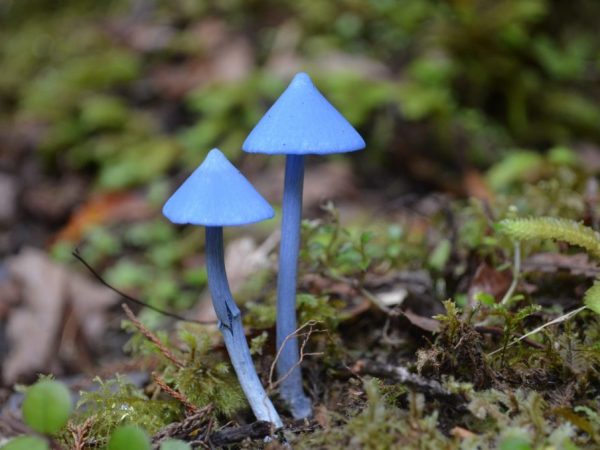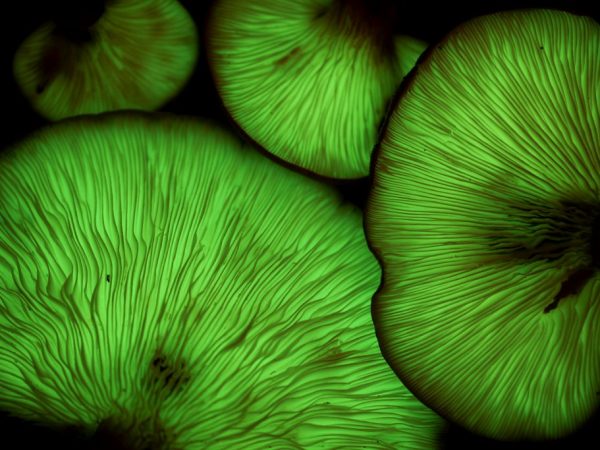Amazing and rare mushrooms in the world
Mushrooms are one of the largest and most diverse groups of living organisms, numbering about 250 thousand species worldwide. Their structural and vital features made it possible to single out these organisms into a separate kingdom - the Mushrooms. There are also unusual mushrooms. They differ from those that we usually collect in appearance, properties and growth conditions.

Amazing and rare mushrooms in the world
General characteristics of mushrooms
Fungi are one of the most controversial forms of living organisms on the planet. Previously, they were attributed to the kingdom of plants, but with the development of science, scientists proved the need to distinguish them as a separate large systematic unit - the kingdom. The reason for this is their differences from plants and animals:
- the structure of the cell of fungi differs from that characteristic of both plants and animals (the presence of several nuclei, the chitinous membrane of the cell);
- unlimited growth in time;
- reproduction using mycelium.
Mushrooms that have fruiting bodies are classified as higher. They are divided according to their structural features and sporulation into Ascomycetes, or Marsupials and Basidiomycetes.
According to human use, 3 groups are distinguished: edible, inedible and poisonous. In addition, fungi also include their microscopic representatives (micromycetes): yeast.
The structure of a common fungus, which is called higher, includes, in addition to the vegetative body (mycelium), the fruit body, which has a cap and a leg, varying in thickness, shape, color and surface structure. In the mushrooms we are accustomed to, they are similar and have only slight differences.
There are many species of representatives of the kingdom of mushrooms on the planet, striking in their appearance, significantly different from the regulars of the mushroom picker basket.
Unusual mushrooms of the world
The most unusual mushrooms can also be found in ordinary places on our planet. Their names are often determined by the peculiarities of their appearance and interesting facts of growth.
The most prominent representative of such mushrooms is white truffle, the undoubted advantage of which is its edibility and high nutritional value. This is a representative of the Truffle family, famous for their underground tuberous fruit bodies. It is rarer than black and grows in Italy, in the provinces of Piedmont and Umbria. Has a shape similar to Jerusalem artichoke, beige-brown skin and light streaked pulp. This unusual mushroom is highly regarded in the world for its taste and unsurpassed nutty aroma.
The next on the list of unique is called luminescent mushroom... He has the unusual ability to glow in the dark, thanks to the biochemical processes taking place in his body. It is common in Japan and Brazil. It grows at the foot of trees, near their broken branches, or simply in damp ground. Not consumed.
Irina Selyutina (Biologist):
Bioluminescence is the ability of various living organisms to glow from the inside. Bioluminescence is based on chemical processes, as a result of which energy is released in the form of light.
Green luminous mushrooms - Mycena Chlorophos were discovered in the 19th century on one of the Japanese islands - Bonin. To date, it has been established that luminescent mushrooms are found not only in Japan, but also spread over the territory of Brazil, Mexico, Puerto Rico, Indonesia and Malaysia. Their number increases sharply after heavy rains.
The same unusual appearance has blue mushroom... It is found in India and New Zealand. Its extraordinary sky blue color is due to the presence of azulene in the pigment. He prefers places with high humidity for growth: among moss, fallen leaves and fern thickets. It is inedible.

Fluorescent mushrooms glow in the dark
The mushroom is considered the record holder for its eerie, but at the same time attractive appearance. bleeding tooth (hydnellum Pekka). It is found in autumn in the coniferous forests of North America, Europe, Iran, Korea. It has a bumpy, white, with a slightly pinkish tinge, an irregularly shaped hat. In the process of growth, drops of red liquid are released on it, attracting insects. The flesh of a young fruiting body is dense, becomes corky in old age. It is not eaten because of its repulsive appearance and bitter taste.
Representatives of unusual inedible mushrooms include a mushroom. bird's Nest, related to mold. The variety got its unusual name because of its original shape, which is really similar to a bird's nest, inside which there are eggs. These are spores that, under the influence of moisture accumulating in them, burst and fly around. The bird's nest is a saprophyte that chooses rotting wood in the forests of New Zealand for growth.
Exotic for us mushroom sea anemone, which looks more like an unusual flower, grows in Australia on a damp forest floor. His hat resembles a coral red starfish, the leg is white. It gives off an unpleasant smell of rotting meat or carrion, which attracts flies that carry its spores.
Irina Selyutina (Biologist):
This amazing mushroom can even be called "cunning". In order not to "provoke" Australians who take walks in a wooded area, at the first stages of its development, it resembles a toadstool in its whitish color. But after a while, the appearance will begin to radically change. And literally in a couple of months a monster is “born”. By this time, his cap is divided into 3-4 parts, which resemble flower petals and acquire a red color. The emitted fetid odor is a defense mechanism against forest four-legged "gourmets".
Another amazing mushroom is considered orange shiver... Her favorite growing spots are dead trees and recently broken branches. The fruit body looks like a gelatinous mass with a sinuous and sticky surface. In the absence of rain, it dries up and shrivels, and when sufficient moisture is supplied, it becomes the same again. The fungus is distributed mainly in the tropical regions of the world: in Africa, Asia, Australia, North and South America.
Rare mushrooms in Russia
Amazing and rare mushrooms are also found on the territory of Russia. Among them there are both unusual inedible and poisonous mushrooms, some have practically disappeared, so information about them is contained in the Red Book.
The names and descriptions of the rare edible and inedible mushrooms are as follows:
- Umbrella polypore (griffola): distributed in the European part of Russia. It has a bushy shape, consisting of numerous legs, connected at the base, and caps with small depressions in the center, beige-brown in color. Prefers deciduous forests. A species similar to it is popularly called a mushroom-ram and is distinguished by a fan-shaped hat. Young fruiting bodies are eaten, old ones are inedible because of the burning taste.
- Giant bighead: it is an edible mushroom of the Champignon family, growing on the edges of forests, meadows, fields, pastures. The fruit body has a spherical, slightly flattened shape, reaching 50 cm in diameter and weighing up to several kilograms. In a young individual, the color is white, with age it acquires a yellowish tint and cracks. Interestingly, having appeared once in one place, this mushroom may disappear completely or not appear there for a long time. therefore, jokingly, these mushrooms are called "meteoric".
- Hericium coral, or coral hedgehog: tasty and healthy mushroom. Due to its rarity, it is listed in the Red Book. It is a parasite, settles on the trunks of weakened trees in deciduous forests of Siberia, the Urals, Dolny Vostok and Krasnodar Territory. In appearance, the fruit body resembles a coral: it consists of small twigs, covered with small fragile spines of white, pinkish or cream color. The pulp is tender with a pleasant taste. Eaten by the young.
- Hericium crested, or Lion's mane: also a parasite on trees. Outwardly, it looks like noodles: small light creamy "thorns" hang down. The pulp is white and firm, and tastes like seafood. The variety is widely used in medicine to remove toxins from the body and lower blood sugar levels. This mushroom grows in the Khabarovsk and Primorsky Territories, the Amur Region of Russia.
- Curly sparassis, or mushroom cabbage: it is a parasite that grows on the roots of trees. It has a bushy, spherical fruiting body, reminiscent of a cauliflower head, white and yellow in color. This is a rare and endangered species listed in the Red Book. It is widespread in Siberia, the Far East and Karelia.
- Cottonfoot pine mushroom: resembles a cone in appearance, with a scaly cap of a gray-brown color. The pulp is whitish, without a pronounced taste and smell. It is used for food, but has a bland taste. Grows in the northern regions of the country.
- Canine mutinus: an unusual mushroom in appearance. Its fruiting body is a formation emerging from the egg membrane at the base, pinkish-yellowish in color without a cap. It is not eaten because of the unpleasant odor, the source of which is the mucous top and toxins. Found in Karelia, Primorsky and Krasnodar Territories.
- An ordinary line: distributed throughout the temperate forests of the country. The cap of the fruiting body resembles in appearance the kernel of a walnut. This mushroom is poisonous (the toxin gyromitrin is present in its body), it is not eaten raw, requires careful and lengthy processing, which, unfortunately, does not always guarantee getting rid of toxins.
Conclusion
The listed mushrooms are far from all of the known, unusual representatives of the kingdom found in the world. Even the poisonous fly agarics, familiar to us, differ from the usual ones in their bright color. Many of the rare representatives of the mushroom kingdom are disappearing, therefore they are protected by the laws of the states on whose territory they grow. In addition, such mushrooms are included in the international Red Data Books.



